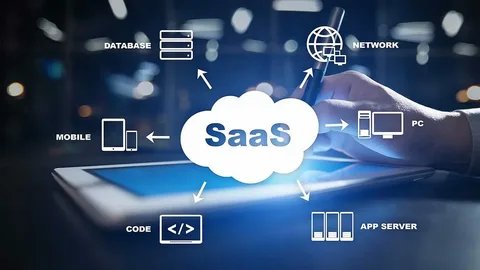In today’s competitive digital landscape, creating a successful SaaS app goes beyond just offering a service—it’s about delivering exceptional user experiences that drive engagement and loyalty. For a SaaS app development company, including a set of essential features in your product is crucial to meet user expectations and solve real problems efficiently. From seamless onboarding to robust security measures, these features not only enhance functionality but also build trust and satisfaction.
Whether you’re launching a new product or upgrading an existing platform, understanding the must-have components is vital for creating an app that is both scalable and user-friendly. This guide explores the key features every SaaS app should incorporate to ensure lasting success and growth in a crowded marketplace.
Clear and Friction-Free Onboarding
First impressions count. A fast and simple onboarding process helps users get started without confusion. They shouldn’t need a manual to begin using your app. Break down steps, use tooltips, and provide a clean interface that guides new users naturally. Walkthroughs, in-app tutorials, and helpful prompts can make a huge difference. The easier it is to get started, the more likely users are to stay.
User Roles and Access Control
Not all users need access to everything. Your app should allow administrators to assign specific roles and control access based on tasks or permissions. This prevents misuse and reduces clutter for the user. A structured hierarchy also helps teams stay organized and secure.
Subscription and Billing Management
Your app must handle subscription models without manual intervention. Build systems that manage user plans, invoicing, receipts, and renewals automatically. Users expect transparency and control over their subscriptions.
Payment Gateways
Integrate with reliable payment gateways like Stripe, PayPal, or Braintree. These platforms offer secure transactions and support multiple currencies. Give users confidence during checkout by using well-known payment options.
Trial Management
Allow users to test your app before they pay. Offer trial periods with clear start and end dates. Notify users about their trial status and make it easy to convert to a paid plan when the time comes. This builds trust and gives them a reason to stay.
Plan Upgrades and Downgrades
Users’ needs change, and your app should adjust with them. Make it simple to switch plans, whether they need more features or want to scale back. Provide real-time updates on how these changes affect their billing or access to tools.
Scalable Infrastructure
Your backend must support growth from a few users to thousands without slowing down. Choose cloud services that adjust to traffic and storage needs. Load balancing, database optimization, and server health monitoring play a key role here. Users should always get the same fast performance, regardless of traffic spikes.
In-App Communication and Notifications
Users appreciate quick updates and real-time communication. Include notifications for key activities such as new messages, system changes, or reminders. Use email alerts, push notifications, and in-app banners. These features help users stay on track and feel connected to the service.
Secure Authentication
Security matters more than ever. Protecting user accounts should be a top priority. Implement strong login protocols and give users confidence that their data is safe.
Multi-Factor Login
Add extra layers of protection through SMS, authenticator apps, or biometric methods. Multi-factor login keeps accounts safe, especially for admin-level users.
Social and Email Logins
Let users sign in using platforms like Google, Microsoft, or Apple. Also, offer traditional email/password options. This flexibility helps reduce barriers during sign-up and keeps users coming back.
Data Export and Reporting
Give users access to their data. Include tools that let them download reports, view analytics, and measure performance within the app. Export formats like CSV or PDF are widely expected. When users can generate reports themselves, they rely less on support and feel more in control.
Easy Third-Party Integrations
SaaS apps rarely stand alone. Users often work across multiple tools. For a custom mobile application development company, offering integrations with popular platforms such as Slack, Zapier, Google Workspace, and CRMs is essential. This saves time and extends your app’s usefulness. A strong API can also let advanced users build custom connections, enhancing flexibility and user satisfaction.
Mobile Responsiveness
Your app must work on phones and tablets, not just desktops. A responsive design adjusts to different screen sizes and remains fully functional. Whether a user is on iOS, Android, or a browser, your app should run smoothly and look good.
Role-Based Dashboards
Each user should see what matters to them. Design dashboards that show relevant information based on their role. A team manager might want metrics, while a regular user needs their task list. Clear layouts improve productivity and reduce confusion.
Admin Panel with Control Features
An admin panel is essential for managing users, reviewing system activity, and enforcing rules. Include tools for account management, usage tracking, and feature control. A well-built panel saves time for your internal team and lets you respond faster to user issues.
Support and Feedback Tools
Good support keeps users happy. Offer help through live chat, ticket systems, or in-app messaging. Provide a feedback form to collect ideas or report bugs. Let users feel heard. A responsive support system often turns frustrated users into loyal ones.
Regular Performance Monitoring
Slow apps lose users. Keep track of server uptime, response times, and error logs. Use monitoring tools to get alerts when something goes wrong. Fixing issues before users notice them improves trust and prevents churn. Regular updates and improvements show users that your team is active and committed.
Conclusion
Launching a successful SaaS app requires more than just coding a few features. The real challenge lies in building tools that support users, scale well, and maintain high standards for performance and security. Each feature listed here plays a specific role in improving the user journey, maintaining stability, and ensuring long-term growth. By including these must-haves, you set your app up for better engagement, fewer issues, and stronger user satisfaction from the very start.


